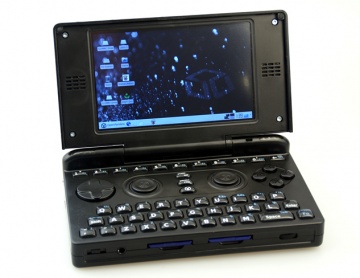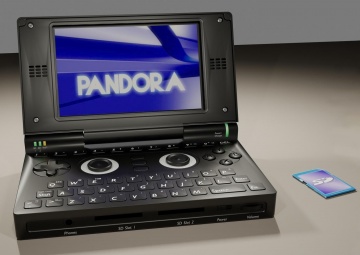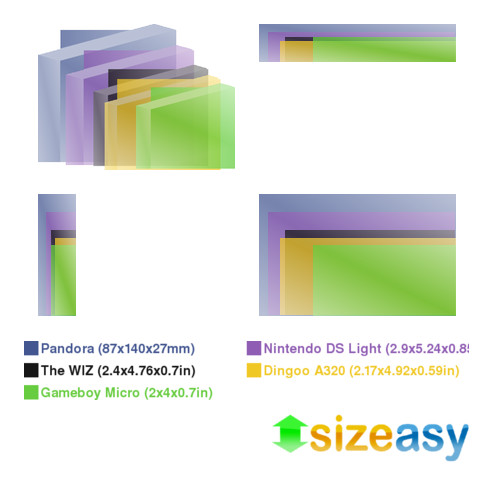Pandora
The Pandora is a seventh-generation handheld game console. When it started shipping in May 2010, it was the most powerful handheld gaming console available and so far it still is.
Contents
Overview
The Pandora runs the Ångström Linux distribution. There will be no fees for developer tools and hence anyone will be free to develop and release software for the system.
Core
The Pandora uses a Texas Instruments OMAP 3530 System-on-Chip. This includes the ARM Cortex-A8 processor, the TI C64X programmable DSP, the PowerVR SGX 530 3D accelerator and supporting components.
Storage
The first revisions of the console included 128MB of DDR RAM, and 256MB of on-board NAND flash memory. However, the final revision that is sold to consumers has 256MB of DDR RAM and 512MB of on-board NAND memory. Storage space is available through 2 SDHC card slots (up to 64GB of storage currently) and via USB host capabilities for connecting any standard USB flash drive and hard drive.
Input
The Pandora includes two analog pads, a directional pad, 4 action buttons, 2 shoulder buttons, 3 function buttons (start/select/home), and a QWERTY keyboard.
Output
The Pandora's display is a 800*480 display, with touchscreen functionality.
TV-out
The Pandora has the ability to output S-video and composite signals to television sets. In addition, picture-in-picture and separate signals for the TV and LCD will be supported.
Sound
The Pandora has a high-quality sound DAC, and an ADC and internal microphone for recording. A pair of stereo speakers are built into the display. The volume control is a wheel.
Keyboard
The Pandora has an almost-full QWERTY keyboard, with additional keys using the Function key and shoulder buttons.
Price
First Batch: 199 GBP(incl. VAT) (approx. $330 USD, 212 € (excl. VAT), later charged in USD due to currency fluctuations.
Second Batch: $349 USD pre-tax. [1] Regional prices will be adjusted at the time of order to reflect current USD conversion rate.
Detailed Specifications
General
- The name: Pandora [2]
- Dimensions: 140 x 83 x 27 mm (slightly larger than a DS Lite: vs 133 mm × 73.9 mm × 21.5 mm, size comparison)
- The first batch of 4000 Pandoras are still available to pre-order if orders are canceled, but only a few are left.
- Pre-ordering for the second batch could start as soon as summer 2010. [3]
- Case is a bit smaller than the GP2X, and will be a mix of metal and plastic. [4]
Core Hardware
- Texas Instrument's OMAP3530 System-on-chip. [5] [6] Specifications can be found at this link: [7]
- PowerVR SGX GPU (OpenGL ES 2.0, several million polygons per second). OpenGL ES demonstrated: [8]
- 256MB of DDR SDRAM in consumer units (early developer units had 128MB).
- Real Time Clock (RTC) built in, to keep track of time. [9]
- 512MB of internal flash memory (NAND) for consumer Pandoras (early developer boards has 256MB).
- Is "unbrickable", through a ROM bootloader.
Display
- 800x480 widescreen (5:3), 4.3 inches, touchscreen LCD.[10]
- Brightness:300 cd/m2, Contrast ratio:450:1, Response time:tr+tf=30ms[11]
- Dimensions: 93.6 x 56.2 mm (4.3 inches, 5:3 aspect ratio).
- TV-out included in hardware, A/V-OUT Port (similar in appearance to a large USB OTG port) outputs S-Video and Composite and inputs 3,5mm Headphone/Microphone cables..
- Separate TV-out signals, picture-in-picture capabilities. [12]
- Powerful 2D and 3D hardware acceleration, see above. [13]
Input
- Buttons, keyboard, microphone, and touchscreen. [14]
- Directional pad will be a D-pad. [15]
- Two real, custom designed, plastic analog nubs.
- QWERTY keyboard (cellphone like, but larger). [16]
- Built-In Microphone [17]
Connectivity
- 802.11b/g (Wi-fi) included. USB host included. USB-on-the-go (one-port host and client) included. [18]
- Integrated Bluetooth 2.0 + EDR (3Mbps)[19]
- USB OTG mini-AB port and fully powered (500 mA) standard-A port. You can use anything that has the appropriate drivers. [20] Some devices need to first go through a powered USB hub.
- RS-232 included, but a level converter is needed for the UART. [21]
- Twin SDIO-capable SDHC slots.
Software
- Open2X-type Linux firmware. [22]
- Custom package system for software installation and updates.
- Potential Emulation: Nearly any game console which predates the Playstation for which an open-source emulator exists. Nearly any 8 or 16 bit computer system for which an open-source emulator exists.
- Atari 2600, 7800, 5200, and Lynx
- Nintendo NES, SNES, Gameboy, GBA and NDS (with combination of inbuilt touchscreen and external TV)
- Sega Master System and Genesis
- NEC PCEngine (TurboGrafx-16)
- SNK NeoGeo, NeoGeo Pocket, and Pocket Color
- Sony Playstation [23]
- Atari 400, 800, and ST
- Amiga
- PC (DOSBox)
- Apple II
- Possible Software:
- Runs a version of the X11 window manager and has the option of a full desktop environment (XFCE).
- You can run most normal programs that run on modern Linux builds as well, provided they do not exceed 256MB of RAM (excluding any virtual memory for performance reasons) and are ported (the source code must be accessible). This includes a full build of Firefox. Firefox 3.0 uses much less memory and resources, and should run fine on the Pandora.
- Some Flash support is possible with some work through the use of Gnash. Maybe not full Flash support, but Gnash will run up to FlashV7 as long as it is ported to the Pandora.
- Youtube videos in FLV can be downloaded and played with mplayer and VLC. Mplayer and VLC will also play other movie files from Firefox, and VLC can also stream FLV easily and can work with Firefox or as a standalone program.
- Advanced multimedia support, including streaming: mplayer, VLC, xine and any other program that is open source is possible. For a general idea of file support for VLC see http://www.videolan.org/vlc/features.html, and for xine see http://xinehq.de/index.php/features.
Power
- Lithium-polymer battery, ~4000mAH.
- Up to 10 hours battery life under reasonable load, 8.5 hours under max CPU load. Up to 100 hours playing MP3s. [24]
- Can charge through an AC adapter or USB. [25]
- Advanced power management capabilities: only need to set a max clockspeed, when the CPU is not doing anything it automatically HALTs and does nothing to save power.[26]
- Will be able to suspend to RAM or suspend to disk for longer battery life and faster start up.


